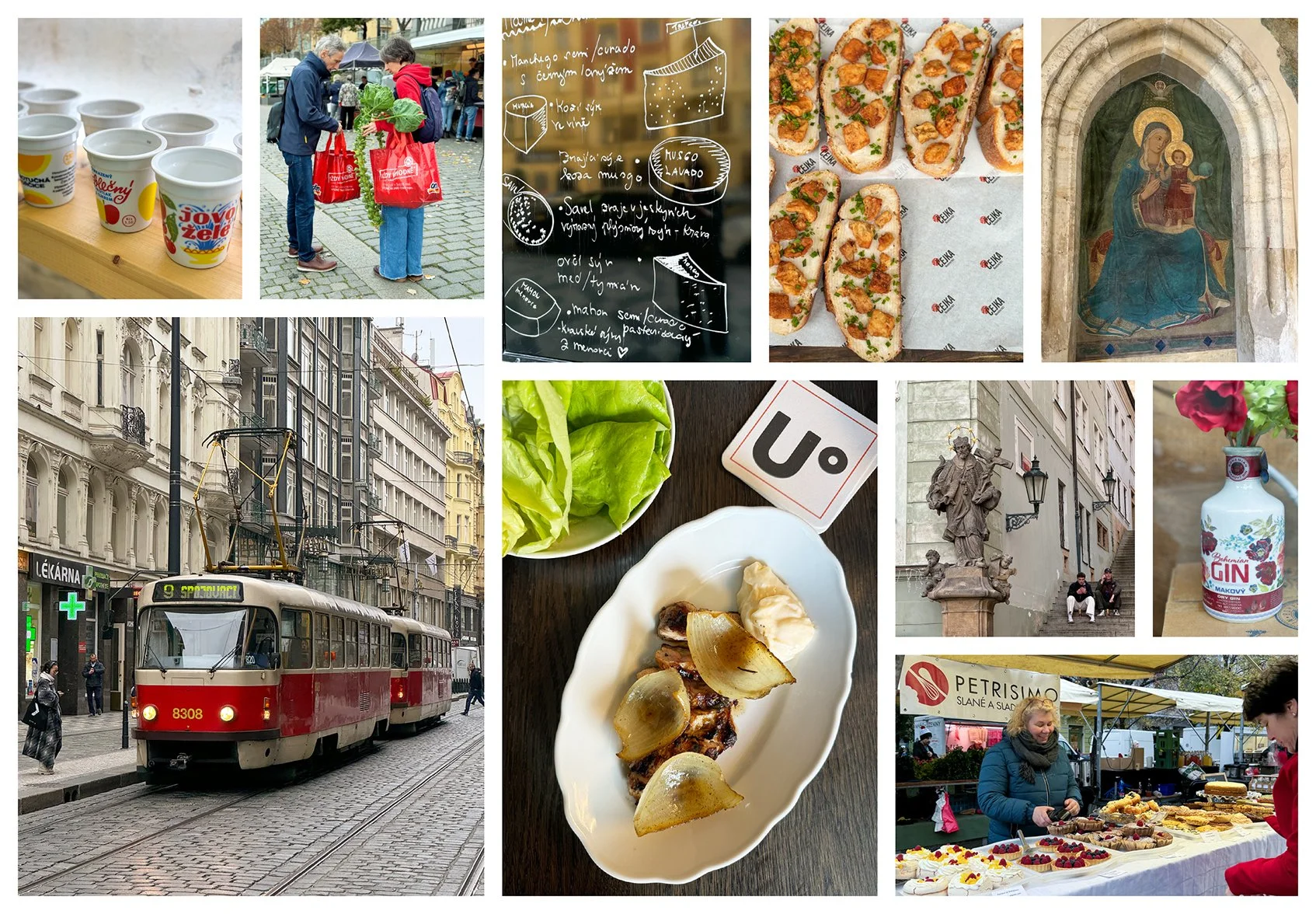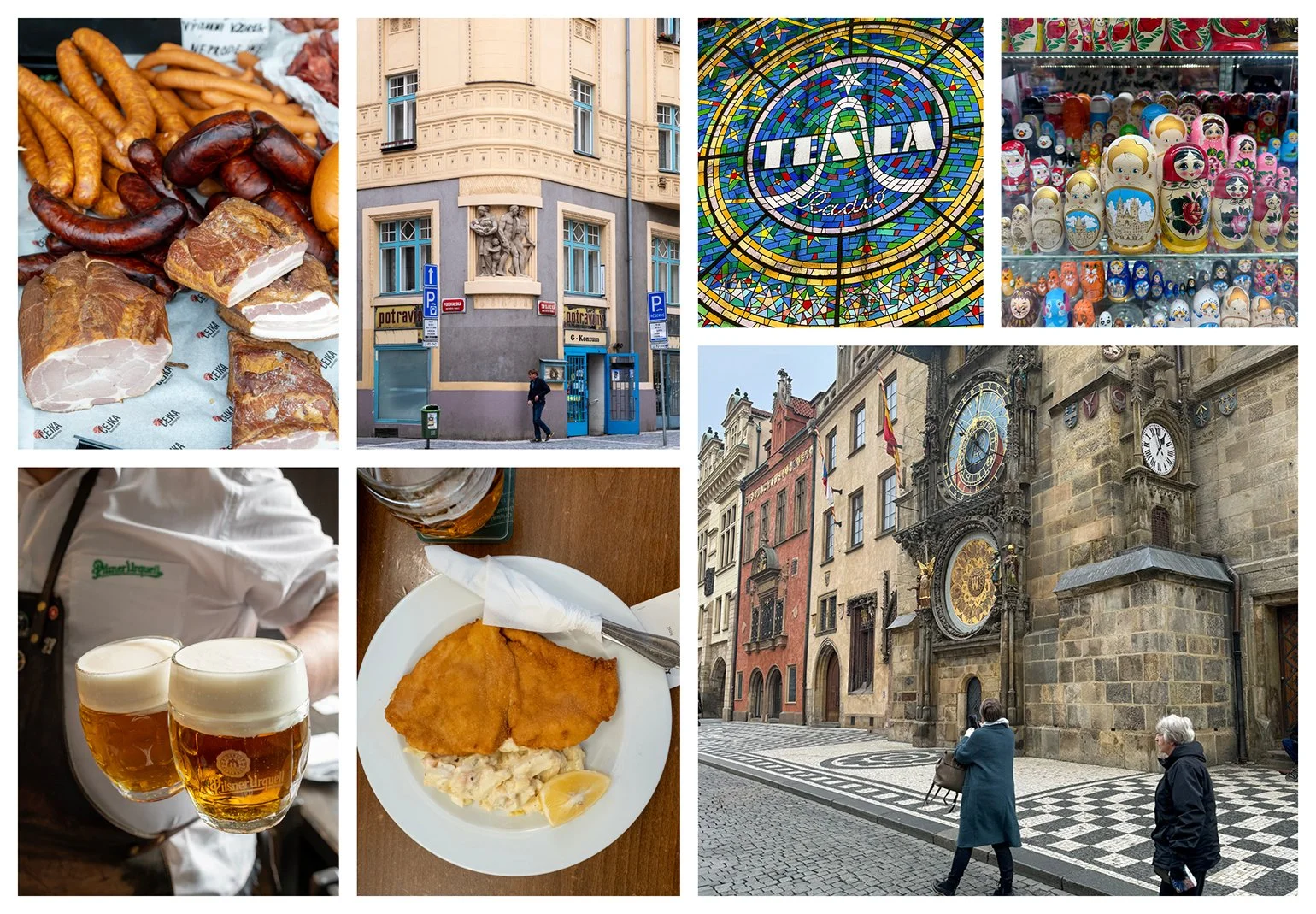A first-timer's Prague. Part 1
By Leanne Kitchen
Prague is a place I’d fancied visiting for the longest time, but knowing it’s so touristy put me off. Ever the chirpy optimist, I took a punt that there would still be real magic in the quieter streets, lesser-known sights, and local’s favourite spots, despite the 7.5 million (or so) annual visitors. I’ve written a day-by-day rundown of how I tried to dodge the crowds on a recent visit and I can’t promise my itinerary was streamlined as I love to walk, don’t mind doubling back, and even enjoy a bit of aimless wandering. Did I see everything? Not even close. But with so much jaw-dropping beauty everywhere in central Prague, skipping the big-ticket sights didn’t bother me a bit. Honestly, the city itself feels like the main attraction, and for me, that was more than enough.
Click here for: A first-timer’s Prague. Part 2
Day 1.
I wake early and leave our AirBNB in Vinohrady, an upscale residential area that’s walkable from the Old Town. Filled with gorgeous apartment buildings, the occasional church, green spaces and other assorted gloriousness, it’s exactly the kind of ‘real’ ‘hood I prefer as a base. Namely, it’s outside of the touristy hoopla but still relatively central. First I beeline to Staroměstské Náměstí (Old Town Square), where I manage to catch the famous Astronomical Clock doing its Astronomical Clock thing; at the top of each hour little windows pop open, wooden Apostles march by, and a cute skeleton pulls a chain and rings a bell. Installed in 1410, it’s one of the world’s oldest clocks still operating and the crowds that assemble a bit later go nuts for it. I way prefer the serenity before the mob arrives.
After a wander through some utterly picture-perfect cobbled streets, I hit Kolacherie for koláče—yeasted pastries topped variously with jam, poppy seeds, or farmer’s cheese, and baked with a crumb topping. Mine is delicious, the place is cute and they make a really decent coffee. Then, it’s on to Dlouhá Street to check out potential meal stops I’d been researching; it’s too early to eat again so this is just a reccie. There’s Sisters Bistro, specialising in chlebíčky (Czech open sandwiches), Naše Maso, a boutique butcher with brilliant meats and a simple burgers-and-sandwiches style of menu, and Lokál Dlouhááá, a modern brewery-restaurant serving hearty Czech fare in an industrial-chic setting. Tick, tick and tick; they all look great! And damn; I want those pig dining plates at Naše Maso something chronic.
I end the morning at the Museum of Decorative Arts, where I lose track of time among incredible collections of Czech applied arts and design. There’s barely a soul here; it’s obviously still too early OR this is not a place on many bucket lists (it should be). Hungry by now, I head to Lokál U Jiráta (sister restaurant to Lokál Dlouhááá) for lunch, where I share a table (it’s that kind of place) and dig into Czech-style beef tartare, cucumber salad, hearty toasts, and a raw garlic clove for rubbing over them. Plus fresh beer straight from the tap; so darned good.
I’m not sure where to head next but somehow I stumble across Emauzský Klášter. It’s a peaceful 12th-century monastery complex complete with 14th-century frescoes, and topped with iconic 1960s white spires that replaced the originals destroyed by a 1945 bombing. It’s relatively deserted and I have the Abbey church blissfully to myself. Vyšehrad Cemetery, the resting place of composers Antonín Dvořák, Bedřich Smetana, and a few other famous names, is my next stop, although it’s a bit of an uphill schlep to get here. I admire the embellished graves, crypts and views until my travel buddy surfaces and suggests a beer at Římská Pivovar, a cool neighbourhood brew-pub right next to our accomodation. The friendly crew don’t speak much English which, along with the delicious drinks (house-brewed beer chased with mulled wine) is our sign from the tourist Gods that we are in the right place. Happy days!
PRO TIPS
Public Transport Hack: Prague’s extensive metro, tram, and bus systems are incredibly efficient and affordable. If you’re 65 or older, public transport is free—just carry your passport as proof of age.
Skip the Crowds: Visit the 9,000 square meter Old Town Square before 8am for peaceful photo ops of the Romanesque, Gothic, Renaissance, Baroque, Classicist and Neogothic buildings, and an unobstructed view of the Astronomical Clock. Otherwise? Welcome to The Mosh Pit.
Money Matters: Most places in Prague accept cards, but it’s handy to carry some Czech koruna (CZK) for bakeries, markets and less touristy spots like local pubs. And the public toilets because as is common in Europe, you pay to use these. Avoid using Euros as you’ll invariably get a poor exchange rate.
Day 2.
It’s Saturday morning, and the weekly Náplavka Farmer’s Market is revving up. Set along the Vltava River, it boasts over 90 vendors: there are family farmers, charcuterie stalls (including fresh sausages grilled on the spot), local cheeses, wild-foraged mushrooms, flowers, crafts, and some top-notch baking. We hit it early when the vibe is still chilled—the setting is gorgeous, with plenty of free tastings, friendly vendors and transportable eating options. After fuelling on sweet buns and coffee, we wander through nearby Nové Město, or ‘New Town’ (home to Vlado Milunić and Frank Gehry’s famed ‘Dancing House’), and pop into the fabulous Czech Design Shop. I fall hard for Martina Klbečková's whimsical pearl and porcelain animal jewellery, niche fragrances from Perfumed Prague, and Rückl's slightly irreverent etched glassware; this turns out to be my fave shop in all of Prague.
I’ve long been fascinated by Operation Anthropoid, so next we visit the Cathedral of Sts Cyril and Methodious where Czech resistance fighters made their final stand against Nazi occupiers after assassinating the hated Reinhardt Heydrich. The memorial in the crypt where they died is essential for fellow WWII buffs—you can still see bullet holes. We debrief over lunch at Restaurace U Kalendů, a solid mod-Czech spot from the clever Ambiente Group (who seem to operate the best places in town), just across from the farmer’s market. Their focus is on fresh beer and nose-to-tail dishes—I try grilled pig’s snout while my travel buddy digs into grilled pork with baked onions and smoked mayo. We’re still stuffed from the market and a tad unnerved by the crypt, so we keep it light and stay out of U Kalendů’s stunning artisanal bakery next door.
We walk lunch off with a trot across the river to explore parts of Hradčany, an area packed with block-buster sights like St. Vitus Cathedral and Prague Castle. But the hordes drive us to Loreto, an historic pilgrimage site with a quiet church, cloister, lovely grounds and a museum of eye-popping liturgical treasures. There are relatively few people and we take this as a crowd-avoiding win. The schlep back to our digs is long, but we enjoy crossing the iconic Charles Bridge despite it being packed, plus Wenceslas Square at twilight, with the newly renovated Grand Hotel Europa (now a W Hotel) sparkling in its art nouveau glory.
PRO TIPS
Avoid Tourist Traps: Restaurants and bars in Old Town Square tend to be overpriced and underwhelming. Venture into neighbourhoods like Vinohrady, Letná, Karlin, or Holešovice for better food, drink, and value. Download the excellent Tom’s Gastro Guide app for the best in local recommends across the gamut.
Support Local Spots: Skip the Insta-famous chimney cake (trdelník)—it’s not Czech, despite the hype. Instead, try authentic pastries like koláče, medovnik (honey cake) or makový závin (poppyseed roll) from bakeries and farmer’s market stalls. You’ll get a taste of real Czech culinary heritage while supporting local businesses.
Beer Culture: Scout out pubs with mainly Czech patrons and beer from small or local breweries—places like U Zlatého tygra in the Old town, Pivovarský klub Benedict in Karlin and U Hrocha over the river in Malá Strana are great examples. Avoid bars pushing “authentic absinthe” tours or cocktails; they’re tourist bait.
Day 3.
I kick off a foggy, damp Sunday with a stroll through the quiet streets of Vinohrady to Hus Congregational House (Husův Sbor). Built in the 1930s, it scratches my Constructivist architecture itch and if you’re into this era too, it’s a must-see. And the history of Jan Hus and the Hussites is fascinating. I meet my Travel Bud at Antonínovo Pekařství because we can’t be bothered waiting for nearby (and much-lauded) Kus Kolache or Kro Kitchen to open. Antonínovo is fine, and nicely busy with dog-walking locals; I love how the pooches are welcomed in cafes here. The weather’s still rubbish so we hit Národní Muzeum (National Museum) to escape it, checking out imposing Basilica of St. Ludmilla, with its 60-meter towers and pretty interior, on the way. Once at the museum, I’m lukewarm on the endless natural history exhibits (although the Hall of Minerals is admittedly mind-blowing), but love the Gothic section and displays to do with Czech political and social history.
Next, we swing by the famous Palác Lucerna in Nové Město (New Town), one of Prague’s first reinforced concrete buildings, and home to David Černý’s quirky horse sculpture. Lucerna contains one of Prague’ many historic pedestrian arcades; another, the nearby Novák Arcade, is in a building with maybe the most stunning art nouveau facade in town, embellished with glittery mosaic tiles. For lunch we hit Sisters Bistro, sampling a selection of their stellar open sandwiches with colourful combos of mayo, meats, pickled fish, eggs, avocado etc. Yum. The excellent Museum of Communism is next and we’d been looking forward to it; as the name suggests it documents life under the Soviet-era regime, including censorship, show trials, art and education. The exhibits are well done and we easily spend a couple of hours; plus dosh. The entrance price, at NZD28 each, is admittedly steep but I reckon it’s money well spent. Our day winds down at a random brew-restaurant I hadn’t researched called U Dvou Koček (‘At The Two Cats’). Bang in the middle of the old town and dating from 1678, we choose from a menu filled with Czech classics like fried cheese, pork ribs, roasted ham hock, roast rabbit, and sirloin in cream sauce with bread dumplings, and take in the gloriously historic interior.
SOME FUN PRAGUE FACTS
Hidden Statues Everywhere: Prague is dotted with works by artist David Černý. Beyond the large one in Lucerna (depicting King Wenceslas riding an upside-down, dead horse), look for the crawling babies on the Žižkov TV Tower, the kinetic head of Franz Kafka in Nové Město, and the hanging Freud sculpture in Husova Street.
Defenestration Capital: Prague is infamous for its historical "defenestrations"—literally throwing people out of windows. The most famous one in 1618 started the Thirty Years’ War!
Underground City: Beneath Old Town Square lies a hidden world of Gothic cellars and medieval streets, buried due to floods and later reconstruction. You can visit parts of this on tours.
Prague's Beer Obsession: Czechs drink more beer per capita than any other nation—around 140 litres annually! Some pubs, like U Fleků, U Medvídků and U Vejvodů have been brewing beer for literally hundreds of years; U Fleků dates back to 1499!













